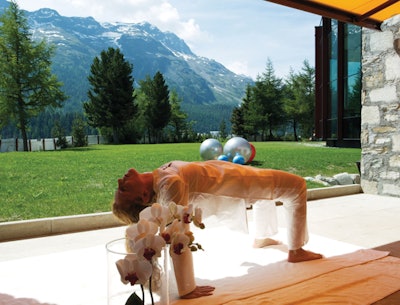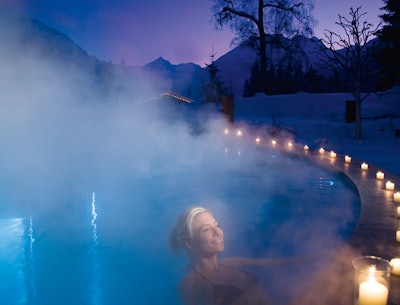 Badrutt’s Palace
Badrutt’s PalaceBadrutt’s Palace
Switzerland’s wellness centers strive to integrate Alpine splendor, old-world charm and off-the-beaten-track treatments.
Switzerland evokes images of winter wonderlands, soaring snowcapped Alps, medieval and baroque architecture, placid lakes and green meadows dotted with docile, hooved animals munching grass as their cowbells sway in the breeze. This prosperous country in the heart of Europe is also known for its popular banking system, Swiss precision timing and geopolitical neutrality. Not surprisingly, Switzerland’s spa culture has been forged by all of these factors.
Wisely, this country’s “spa meisters” seek to organically incorporate the unspoiled grandeur of their surroundings into the wellness experiences they offer, ensuring that the region’s resplendent scenery is an ever-present aspect of the healing process. Preserving nature is all-important for the Swiss—not only for the Green Party, which counts elected members in parliament—but for hoteliers, too. On a previous visit, Urs Hauser, whose family owns the eco-award-winning Hotel Belvedere at Grindelwald overlooking the Jungfrau, told us, “This is one of the most spectacular mountainous areas in the world, and if we don’t preserve it, it’s like cutting off the branch we’re sitting on.”
A peaceful state of mind is the essence of Switzerland, which hasn’t fought a war in 165 years. This is a society that values high efficiency, yet exudes a sense of calm, where the world’s greatest timepiece manufacturers reside, and where the much-traveled trains always run on time. But those who live by the clock need places to unwind, and they do so at oases of bubbly, warming waters and caressing fingertips.
However, Switzerland’s prosperity has made it a victim of its own success. Spa managers relayed to us how being (arguably) the planet’s most affluent nation has produced a whole set of unforeseen challenges. In the spa world, 21st-century multi-cultural realities have led to unexpected treatment trends. Switzerland is now a place where East meets Alpine, and tradition meets innovation.
Here’s what we learned about contemporary Swiss spa culture when we punched the cuckoo clock at three of Switzerland’s top wellness centers.—By Ed Rampell

Gstaad Palace
Holding court on a hilltop in a verdant valley of Bern canton in the southwest of Switzerland, Gstaad Palace—which celebrates its centennial this year—epitomizes the grace and gentility of a bygone era. The turrets and spires of its elegant structure speak of its status as a haven for the rich and famous, a place where aristocrats rub elbows with international jet-setters. Guests have included Elizabeth Taylor, Richard Burton, Louis Armstrong, Ella Fitzgerald, David Niven and Peter Sellers, who shot a Pink Panther movie here. Today, the five-star facility features a well-equipped Technogym, heated Olympic-sized pool, and indoor and outdoor tennis courts (with coaching by tennis pros such as Grand Slam champion Roy Emerson). With 150-plus miles of slopes at its doorstep in the Bernese Oberland, 3,440-foot-high Gstaad is a mecca for mountain climbers, skiers, bikers, trekkers and the like.
After a few hours spent roughing it in this Alpine arcadia, guests eagerly seek the curative services that await at the The Place’s Spa & Health Club. The 6,000-square-foot, state-of-the-art wellness center boasts eight treatment rooms, saunas, steam baths, a solarium, private spa suite, indoor pool, and an outdoor pool and Jacuzzi that open up to a majestic, mountainous panorama. Indoors, subdued lighting, stone walls, wooden ceilings, plush furniture and a circular stone fireplace encourage guests to cozy up, munch on dried fruit and nuts, sip tea and enjoy some native serenity.
“We take care that the materials (wood, stones) and the products that we use come from the region,” says spa manager Laura Tedino. “This gives our spa a special Swiss atmosphere.” (The spa’s skincare and other product lines are derived from aromatic or medicinal roots, leaves and flowers, all sourced from a remote pasture in the Swiss Alps’ foothills.)
The Palace Spa serves clients of all ages, including hotel guests, locals and residents of Les Chalets du Palace, an adjoining luxury apartment residence. The business’ biggest challenge, according to Tedino, is “the strong Swiss Franc.” Although the euro is widely used, the Swiss franc is still the coin (and paper) of the realm, and Switzerland’s prosperity makes the Alpine nation prohibitively expensive for many tourists. One-third of the Palace’s patrons are Swiss, who are largely able to manage their country’s higher prices, yet the economic downturn has still resulted in guests “becoming more price-sensitive,” admits Tedino. “Our 2012 summer season was weaker than last year’s.” Fortunately, and not surprisingly considering the location, winter bookings are “still healthy,” she adds.
Marketing efforts include everything from extending operating hours to implementing a kids’ program to offering special packages and discounts. Tedino works closely with the sales and marketing departments, which employ all manner of print and online media to spread the word. Says Tedino, “We focus on the main markets—Switzerland is the biggest—and target booming markets in Brazil, Russia, India and China.”

Park Weggis
In his 1880 work A Tramp Abroad, Mark Twain wrote, “the beauty of the lake [Lucerne] had not been exaggerated… in truth, a trip on that lake is almost the perfection of pleasuring.” Indeed, guests can attain such pleasure at Park Weggis’ Sparkling Wellness center, ranked 2012’s Best Day Spa in the Swiss business magazine Bilanz. The stately hotel opened in 1875 along the banks of Lake Lucerne, with the snowy summits of Mt. Pilatus, Mt. Rigi, etc., unfolding before it. But Twain, who once stayed at the resort, would be astonished today by the Tibetan influence that has since taken glorious hold of the resort.
The Sparkling Wellness center consists of six traditional, Japanese-style wood and stone cottages discreetly tucked behind the resort’s 19th-century buildings, among a garden of rocks and 100-plus-year-old, imported bonsai trees. This decidedly Eastern accent is a major selling point,
says manager Brigitte Bünder. “We always try to be different and ahead of our competitors, and were the first to add private spa cottages. Our Tibetan treatments are also unique in Switzerland,” asserts Bünder, who received a 2012 Wellness Aphrodite award for Best Spa Manager from the German magazine Top Hotel.
After China seized the Himalayan kingdom and the Dalai Lama fled, many Tibetans went into exile; but some, drawn by the Alps that reminded them of home, relocated to Switzerland. “We offer authentic treatments using herbs, oils and stones from Tibet,” reports Bünder. “Our Tibetan therapists are educated in their ancient culture of massage. Many have trained in Tibetan monasteries or schools.”
Park Weggis holds particular appeal for Americans, who Bünder says are “searching for a more private atmosphere. They are really impressed when they see that there are private rooms to rent with sauna or steam bath, Jacuzzi, cold water pool with natural river stones, waterbed and a surround-sound media system.” Yet, there is also space for family or friends, she says, adding, “Swiss tradition is to join with others for a time-out in a public sauna, steam bath and wellness area.” She concludes that American and Swiss citizens share high expectations with regard to the quality of a spa’s interior design, atmosphere, products and treatments. Weggis’ newest offering is a stem cell center led by famed cosmetic dermatologist Dr. Harald Gerny, which offers state-of-the-art serums paired with meso needling techniques.
Nevertheless, the economy is having its expected impact. “Our hotel and spa is affected by the difficult economy in Europe and the strong Swiss Franc,” Bünder confesses. “Switzerland has become more expensive for foreign tourists, and Swiss citizens take advantage of the situation to travel abroad more often.” She’s quick to add, however, that “in Switzerland one still gets excellent value for their money.”
To help counter the effect of economic realities, the resort taps into its reputation. “We are a member of the Swiss Deluxe Hotel association, and part of the international Relais & Châteaux organization,” says Bünder. “Through these associations we are marketed worldwide via guides, websites, newsletters, etc. We also often take part in showcases or road shows in Switzerland and worldwide, organized by the aforementioned organisations or by Switzerland or Lucerne tourism.” The spa also participates in beauty exhibitions, and publicizes its activities online via its own marketing and public relations department.
In the end, though, this business thrives the same way as do spas all over the world. As Bünder proudly maintains, “The best marketing is still the word-of-mouth recommendations from our guests!”

Badrutt’s Palace
Located at ritzy St. Moritz in the Engadin Valley near the Italian border, Badrutt’s Palace, which opened at its present site in 1896, boasts chateau-style design and old-world chivalry. Its cutting-edge Palace Wellness was devised as part of a $47 million makeover in 2009.
Here, guests access the spa via an elevator descending into a grotto. A large indoor pool features a granite faux waterfall obscuring a Jacuzzi, all surrounded by picture windows with unobstructed views of Lake St. Moritz. Adjacent is the Wet Zone, the area’s epicenter, which encompasses the Ice Room, Mist Room, Aroma and Salt Steam Rooms, and a variety of ladies-only and mixed saunas. A relaxation room offers plush leather lounge chairs, headphones and stunning vistas of the lake and Alps. Two spa suites stand ready to accommodate couples. And the Treatment Center offers an Alpine Garden encircled by 10 rooms named after flowers growing in the surrounding Engadin valley. Just outside awaits a small outdoor pool, and a tennis court that doubles as an ice-skating rink during winter.
Palace Spa’s wellness advisor is Martha Wiedemann, wife of managing director Hans. Originally from India, Wiedemann believes that the chief difference between Switzerland’s spa culture and what Americans are accustomed to is the interpretation of the word “spa.” “In Switzerland, ‘spa’ relates to a therapeutic experience, whereas in America, it often has a broader meaning, such as ‘day spa,’ ‘beauty spa,’ ‘nail spa,’ and even ‘dog spa,’” she says. But both cultures, she adds, “aim at delivering the ‘feel good experience,’ and stress the prevention of ailments via systems that balance the daily lifestyle: exercise, antiaging programs and stress management therapies.”
But what draws the lion’s share of clients is the resort setting. “We attract a largely ‘holiday-type clientele,” Wiedemann acknowledges. “For some it’s the purity and unpolluted nature emcompassing the Swiss Alps, and the design of the wellness center that complements this setting. We bring the ‘Engadin’ into the center, so the overarching feel is of being in the mountains.” Treatment rooms are built with local cembra pine and granite from the nearby Bernina Pass. And those epic picture windows integrate the incomparable Alpine and lake scenery as essential elements along the path
toward tranquility.
Considering the hefty price tag for the 2009 upgrade, Wiedemann admits that Palace Spa’s biggest challenge has been the “return on investment.” Even so, global economics have not impacted this dramatically. “We have an established and loyal clientele, and we remain unique,” she asserts. “We maintain the best aspects of tradition along with the most advanced systems—without compromising on service and luxury.”
Loyal clients notwithstanding, attracting new guests is important, so the spa offers tour introductions to foster immediate interest. And it is continually upgrading itself. “We are at the forefront of trends, have the latest equipment, and offer services and facilities for most age groups,” says Wiedemann.
“We’re constantly promoting in the right markets through our website, or introducing our product within travel packages to potential new clients. We also work at keeping a high profile in new markets like India and China.”
And the spa knows its customer. Notes Wiedemann, “We engage media access to clients in the luxury market via public relations, in-house and word of mouth.”











